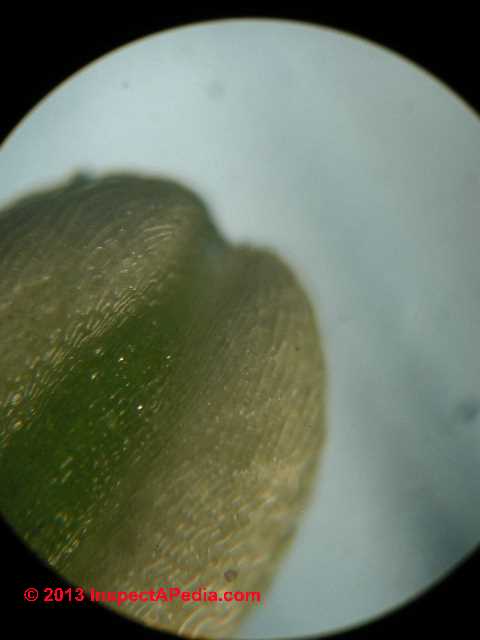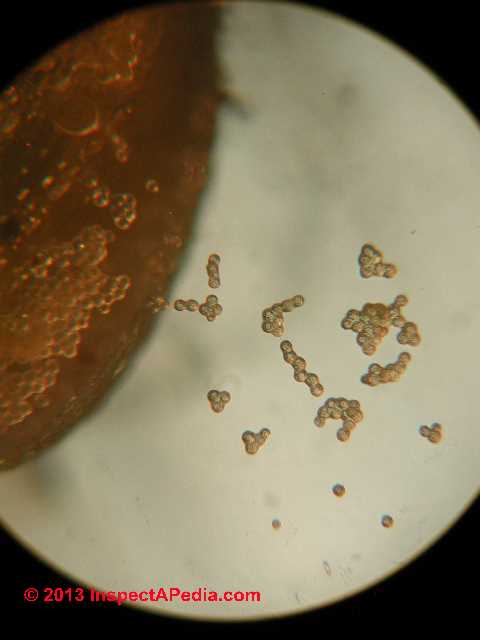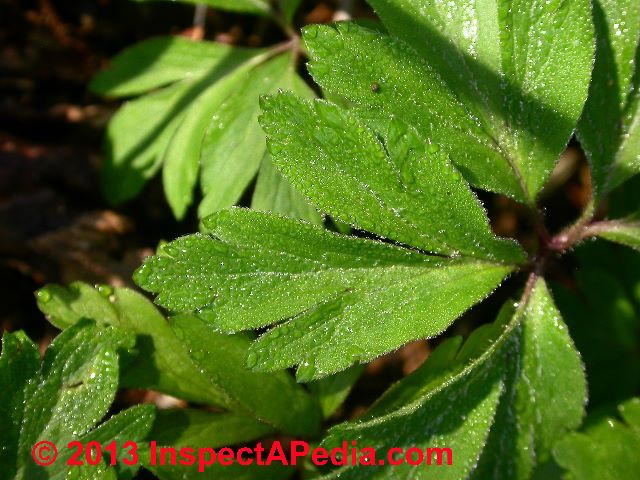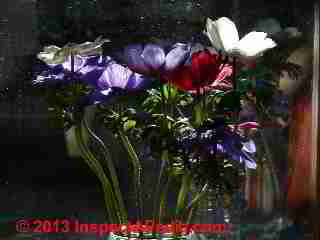 Anemone flower pollen & flower photographs
Anemone flower pollen & flower photographs
- POST a QUESTION or COMMENT about anemone pollen, flowers, & microphotography
Anemone pollen photographs & facts:
This article presents photographs of anemone flowers and their pollen using macro & microphotography.
We discuss choices of microscope slide mountant fluids and their effects on pollen grains and thus on their appearance as well as the effects of time on a pollen grain's absorption of the mountant liquid.
InspectAPedia tolerates no conflicts of interest. We have no relationship with advertisers, products, or services discussed at this website.
- Daniel Friedman, Publisher/Editor/Author - See WHO ARE WE?
Photographs of Anemone Flowers and their Pollen

Daniel Friedman
This little article is dedicated to Dr. Michael Muilenberg and Dr. Christine Rogers, University of Massachusetts, Amherst & Department of Environmental Health, Harvard School of Public Health, for their generous gift of time and education that stimulated my interest in aerobiology, bioaerosols, pollen, and microscopy.
The Anemone genus, a member of the buttercup family, includes at least 120 flowering plants all of the family Ranunculacae found in temperate zones.[2]
Shown here are de Caen variety Anemone flowers and their pollen grown locally in the Hudson Valley of New York at Battenfeld's Anemone Farm in Red Hook NY and sold locally at Adams Fairacre Farms stores. [3]
Click any InspectApedia image to see an enlarged, detailed version.
According to Battenfeld anemones are native to the Middle Eastern countries but were probably brought back to Europe by Crusaders from the Holy Land. In these photographs of Anemone flowers and pollen we are showing the Battenfeld cultivated variety.
Peterson's Field Guide to Wildflowers [Amazon.com] includes several Anemones including the Wood Anemone, Anemone quinquefolia and the Mountain Anemone, Anemone lancifolia. [4]
The Wood Anemone (Wind Flower) illustrated at left often accompanied by the smaller Rue Anemone are often found as a wildflowers together in New York [7] blooming in April and early May.
We illustrate the WOOD ANEMONE flower photos and its anther and pollen later in this article.
Let's enjoy a series of closer looks at the de Caen Anemone in a sequence of photographs zooming in on the pollen center of this beautiful flower family.

Using the macro close-up facility of a Nikon Coolpix 4500 we've zoomed in on the pollen-producing components of the Anemone, its anthers or pollen filaments.
See MICROSCOPE CAMERA SELECTION
More about these photographic methods can be read
at MICROSCOPE DI GITAL PHOTOGRAPHY
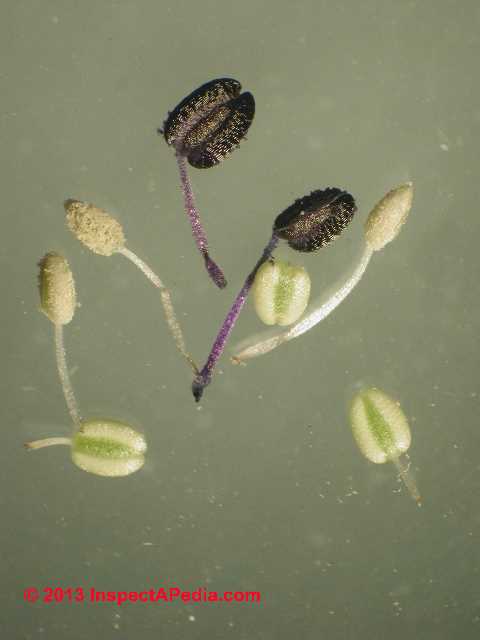
In the stereo microscope a magnified view of anthers from one of our blue-violet Anemones (center) and the greenish anthers from our white Anemone are shown in their form.
Interesting to observe, some of our white anemones had all dark pistil, stamen, anther components while one of our white anemones displayed pale green versions of these components. The latter's anthers are the white-green members of our photograph at left.
The pollen collected from the various Anemone anthers will often show a color hue matching the source anther, provided you don't have a too-heavy hand with stain when preparing the microscope slide mounts.
At the magnification above, also taken using our stereo microscope, we begin to see the point of overlap in magnification range between this device and the low-power 10x objective on our high power forensic microscope images that follow.
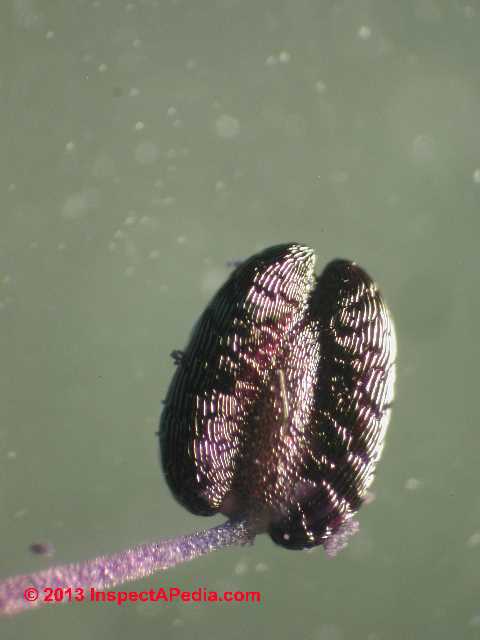
The Anemone photographs below were taken using the 10x objective, actually at 120x in our lab microscope.
Below in the next pollen photo you can see strings of pollen grains being released from the plant. I think that the degree to which these pollen grains are adhered in chains and a clump are probably not natural and are an artifact of my rough handling of the anther during mounting.
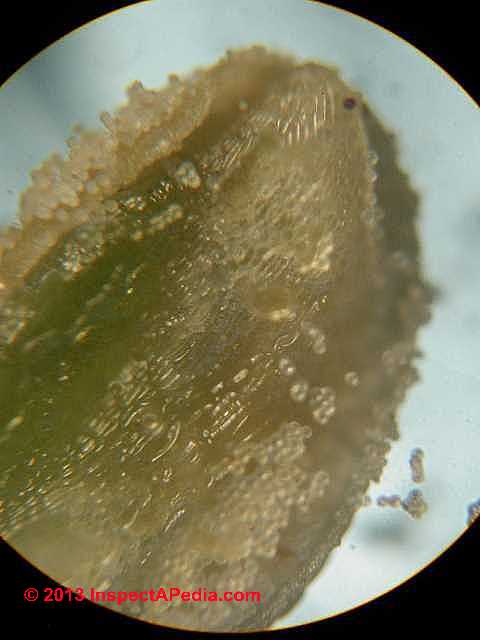
The Anemone anther and pollen photo at above right in the stereo microscope, and at below left in the high power transmitted light microscope (we added reflected light), were taken of dry-mounted flower components.
But to obtain a decent view of individual pollen grains (beginning at below right) we used several mounting media including Calberla's solution[5] and lactophenol.
Actually water or alcohol can hydrate pollen quite rapidly as well and are suitable for non-permanent slide mounts.

In our Anemone pollen photographs below we have magnified the pollen to 1200x using transmitted light and a lactophenol mountant to avoid over-hydration. This preserved the original shape of the pollen and also allowed us to examine its surface features.
The two photos above and then below illustrate the importance of focusing up and down on small particles to observe their various surface and perimeter properties.

And below we have mounted the same Anemone pollen shown above using Calberla's solution - a formulation intended to rapidly hydrate pollen for close examination.
This treatment provides an excellent view of the pollen cell wall and often internal features, but it may so puff up the pollen grain that its native shape and surface features are lost to view.
At below right you can see our Anemone that ports a pale green center.
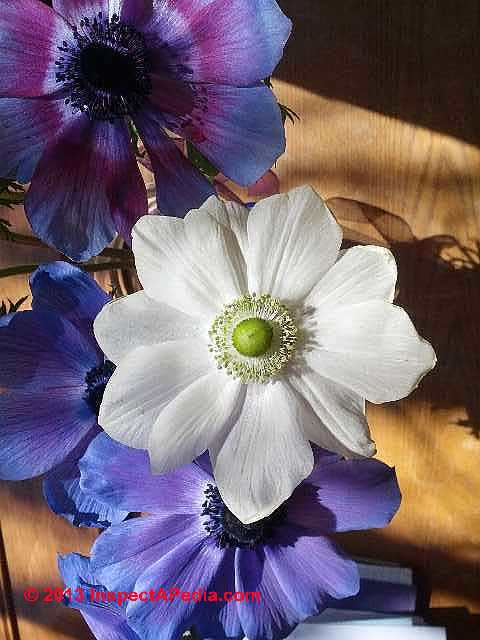
Wood Anemone Flower & Leaf Identification Photographs
The Wood Anemone, Anemone quinquefolia [4][7] or in more recent references Anemone nemorosa [8] with common names windflower, thimbleweed, smell fox and helmet flower are shown in our photographs just below is often accompanied by the smaller Rue Anemone found as a wildflowers together in New York blooming in April and early May. [4]
These photographs of the wood anemone were taken at the author's home on 24 April 2014.

Above we illustrate a cluster of Wood Anemone flowers covered with morning dew and at below, an individual flower in its position of night-time repose. From this photo you can see why some referred to this as the helmet flower. During the day these flowers may lift and open quite a bit more than shown.
The Wood Anemone (Wind Flower) illustrated here was described by Chester A. Reed, S.B., Mohonk Lake NY in is little book Wildflowers of New York published in 1912. [7]

Below you can see the yellow and green center of the Wood Anemone flower and at above right we illustrate the flower's leaf pattern.
These flowers appear in clusters close to the ground in wooded areas, typically 5-15cm in height and produce a single flower per stem.
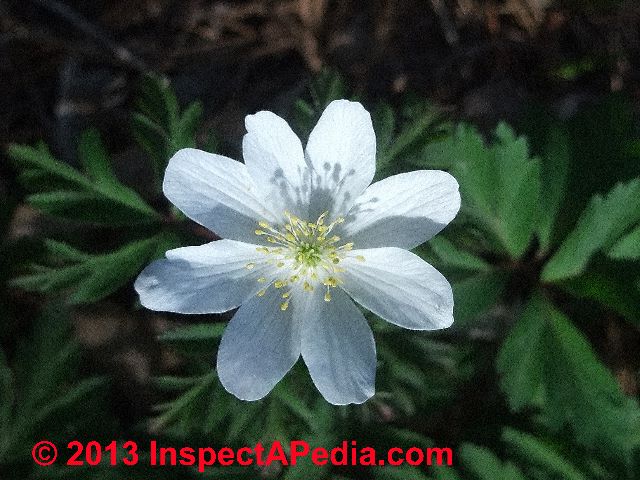
At above left you can see the same Wood anemone having opened its petals to the sun. This flower was also photographed 4/24/2013 but was found growing wild in New York's Shawangunk mountains in the Mohonk Preserve (below).
Most of our Wood anemones here were white but a few clusters showed a lovely pink hue. Yellow wood anemone, Anemone ranunculoides, also known as the buttercup anemone not shown here is a similar plant with slightly smaller flowers of rich yellow colouring.[8]
At below left we illustrate the pollen-coated anther from the Wood Anemone.
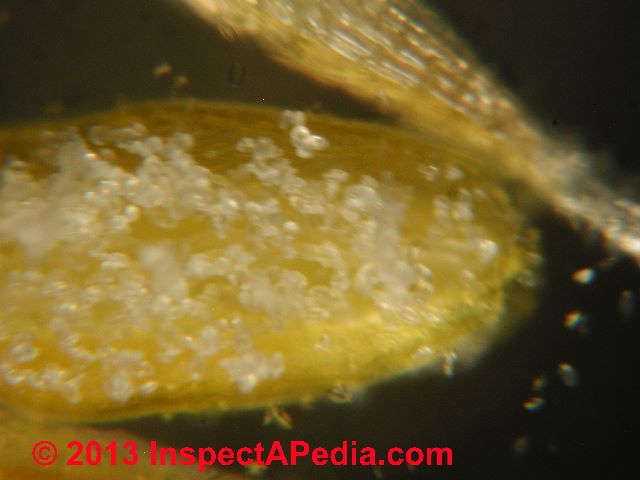
At above right is a 1200x photograph of the Wood anemone's pollen showing some characteristic features and noting that its pollen is distinctly different from the de Caen Anemone shown earlier in this article.
(Other images are available on request.)
...
Continue reading at BIRCH POLLEN or select a topic from the closely-related articles below, or see the complete ARTICLE INDEX.
Or see these
Recommended Articles
- ALLERGENS in BUILDINGS, RECOGNIZING
- ANEMONE FLOWER POLLEN
- BIRCH POLLEN
- CACTUS FUNGI / MOLD
- MILDEW REMOVAL & PREVENTION
- MOLD APPEARANCE - WHAT MOLD LOOKS LIKE
- MOLD by MICROSCOPE
- PAPAYA WHITE GROWTH vs DISEASE
- POLLEN PHOTOGRAPHS
- POLLEN STAINS on BUILDINGS and how to get them off of surfaces
- RED SPRUCE IDENTIFICATION & POLLEN PHOTOS
Suggested citation for this web page
ANEMONE FLOWER POLLEN at InspectApedia.com - online encyclopedia of building & environmental inspection, testing, diagnosis, repair, & problem prevention advice.
Or see this
INDEX to RELATED ARTICLES: ARTICLE INDEX to BUILDING FORENSICS
Or use the SEARCH BOX found below to Ask a Question or Search InspectApedia
Ask a Question or Search InspectApedia
Questions & answers or comments about anemone flowers & their pollen
Try the search box just below, or if you prefer, post a question or comment in the Comments box below and we will respond promptly.
Search the InspectApedia website
Note: appearance of your Comment below may be delayed: if your comment contains an image, photograph, web link, or text that looks to the software as if it might be a web link, your posting will appear after it has been approved by a moderator. Apologies for the delay.
Only one image can be added per comment but you can post as many comments, and therefore images, as you like.
You will not receive a notification when a response to your question has been posted.
Please bookmark this page to make it easy for you to check back for our response.
IF above you see "Comment Form is loading comments..." then COMMENT BOX - countable.ca / bawkbox.com IS NOT WORKING.
In any case you are welcome to send an email directly to us at InspectApedia.com at editor@inspectApedia.com
We'll reply to you directly. Please help us help you by noting, in your email, the URL of the InspectApedia page where you wanted to comment.
Citations & References
In addition to any citations in the article above, a full list is available on request.
- [1] Dr. Michael L. Muilenberg, & Dr. Christine Rogers, Amherst MA.
- [2] Wikipedia Web: https://www.wikipedia.org/ provided background information about some topics discussed at this website provided this citation is also found in the same article along with a " retrieved on" date. NOTE: because Wikipedia entries are fluid and can be amended in real time, we cite the retrieval date of Wikipedia citations and we do not assert that the information found there is necessarily authoritative. Anemone entry, http://en.wikipedia.org/wiki/Anemone, retrieved 4/4/2013.
- [3] Battenfeld's Anemones Farm, 856 Route 199, Red Hook Ny, 12571, Tel. 845-758-8018. Website: http://www.anemones.com/battenfeld-history.html . Battenfeld's is the world's premier source of hybrid anemones. Quoting:
The Battenfelds have been family farmers in this country for more than one hundred years. The tradition goes back to a determined patriarch, Conrad Battenfeld, who came to America from Germany with his wife Elizabeth in the 1880's. - [4] Roger Tory Peterson, Margaret McKenny, A Field Guide to Wildflowers, The Peterson Field Guide Series, Houghton Mifflin Co., Boston 1968, ISBN 0-395-08086 / ISBN 0-395-183251
- [5] Formula for Calberla's solution: Calberla's Solution can be purchased from microscope and lab supply companies or you can prepare your own mixture by combining 5 ml glycerol, 10 ml of 95% ethanol, and 15ml of distilled water to which one adds a small amount (perhaps just two drops) of aqueous basic fuchsin solution.
Watch out: test the concentration your basic fuchsin solution before adding it to the Calberla's solution mixture above to be sure it is not too intense. Too much stain obscures the natural color of bioaerosol particles, losing that feature of their identifying properties. Stain can, however, bring out features in hyaline (colorless) or low-color particles such as skin cells and some pollen grains or mold spores. For use with pollen your Calberla's solution should be a light pink. - [6] New York Botannical Garden, Lesson Topic: Pollen Power, (grades 6-8), www.nybg.org/files/schoolgardens/6-8-pollen-power.pdf, retrieved 4/5/2013, [copy on file as Pollen_Info_NYBot_Gardenr.pdf]
- [7] Wildflowers of New York, [large PDF] Chester A. Reed, S.B., Mohonk Lake NY 1912. This book is long out of print but via the link in this citation we include a PDF version for our readers.
- [8] Wikipedia Web: https://www.wikipedia.org/ provided background information about some topics discussed at this website provided this citation is also found in the same article along with a " retrieved on" date. NOTE: because Wikipedia entries are fluid and can be amended in real time, we cite the retrieval date of Wikipedia citations and we do not assert that the information found there is necessarily authoritative. Anemone nemorosa citation retrieved 4/24/2013, original source http://en.wikipedia.org/wiki/Anemone_nemorosa.
- [9] Shirreffs, D.A. 1985. Anemone nemorosa L. Journal of Ecology 73: 1005-1020.
- [10] Chris Philip (2008-04). Plant Finder 2008-2009. ISBN 978-1-4053-3190-6.
- Trees, Taylor's Guide to, Chanticleer Press, ISBN 0-395-46783-7
- "IgG Food Allergy Testing by ELISA/EIA, What do they really tell us?" Sheryl B. Miller, MT (ASCP), PhD, Clinical Laboratory Director, Bastyr University Natural Health Clinic - ELISA testing accuracy: Here is an example of Miller's critique of ELISA - www.betterhealthusa.com/public/282.cfm - Townsend Letter for Doctors and Patients
The critique included in that article raises compelling questions about IgG testing assays, which prompts our interest in actually screening for the presence of high levels of particles that could carry allergens - dog dander or cat dander in the case at hand.
- www.tldp.com/issue/174/IgG%20Food%20Allergy.html - contains similar criticism in another venue but interestingly by the same author, Sheryl Miller. Sheryl Miller, MT (ASCP), PhD, is an Immunologist and Associate Professor of Basic and Medical Sciences at Bastyr University in Bothell, Washington. She is also the Laboratory Director of the Bastyr Natural Health Clinic Laboratory. - Allergens: Testing for the level of exposure to animal allergens is discussed at http://www.animalhealthchannel.com/animalallergy/diagnosis.shtml (lab animal exposure study is interesting because it involves a higher exposure level in some cases
- Allergens: WebMD discusses allergy tests for humans at webmd.com/allergies/allergy-tests
- In addition to citations & references found in this article, see the research citations given at the end of the related articles found at our suggested
CONTINUE READING or RECOMMENDED ARTICLES.
- Carson, Dunlop & Associates Ltd., 120 Carlton Street Suite 407, Toronto ON M5A 4K2. Tel: (416) 964-9415 1-800-268-7070 Email: info@carsondunlop.com. Alan Carson is a past president of ASHI, the American Society of Home Inspectors.
Thanks to Alan Carson and Bob Dunlop, for permission for InspectAPedia to use text excerpts from The HOME REFERENCE BOOK - the Encyclopedia of Homes and to use illustrations from The ILLUSTRATED HOME .
Carson Dunlop Associates provides extensive home inspection education and report writing material. In gratitude we provide links to tsome Carson Dunlop Associates products and services.





